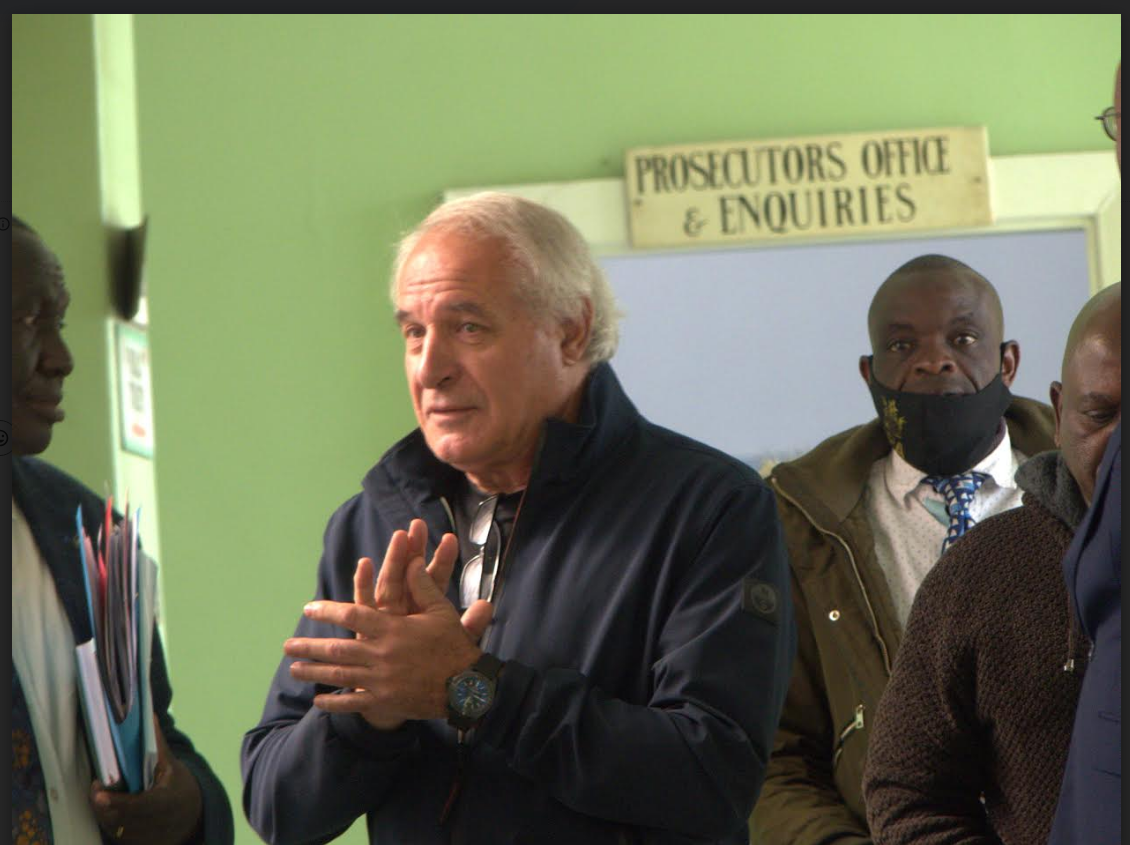
A gang of workers fully clad in safety clothing comprising of helmets, gloves and boots wait to go down the mine shaft at Nigel West Mine in Filabusi, Matabeleland South province.
With their helmet-mounted torches in position, the 12-man gang makes a beeline as they go down the shaft.
“We are very concerned about the health and safety of our miners,” said one of the managing directors at Nigel West Mine, Milton Mathe.
“As Nigel West Mine, we do everything possible to keep our workers safe and healthy by following safe mining practices.
“Our safety rules and regulations should be followed by those underground and on the surface.”
Mathe said as such, Nigel West Mine has recorded a few cases of accidents, moreso of fatalities compared to other small-scale mines.
The recent mine disaster at Bay Horse Mine in Chegutu has raised concern about artisanal miners' and small-scale miners’ safety compliance in the country.
As the search and rescue operation continues, questions are being asked about the measures in place to protect miners and prevent such tragedies from occurring in the future.
- Disgruntled chrome miners meet govt over poor prices
- Small scale miners call for gemstone trade liberalisation
- Govt blocks small-scale miners from lithium fields
- ‘Govt to regulate artisanal miners’
Keep Reading
The disaster, which claimed the lives of nine artisanal miners and left many others injured, was caused by a shaft collapse, possibly due to poor safety protocols, preliminary investigations show.
According to a research in the International Journal of Environmental Research and Public Health titled Accidents, Injuries, and Safety among Artisanal and Small-Scale Gold Miners in Zimbabwe, the prevalence of accidents and injuries among artisanal and small-scale miners in Zimbabwe is 35% and 25.7% respectively.
The report says accidents associated with experiencing injuries included mine collapses and underground trappings.
The major injury risk factors were digging, blasting, crushing and the underground transportation of workers and materials.
Injuries were reported to be highest among the miners working 16 to 24 hours per day.
According to the Zimbabwe Miners Federation (ZMF), the apex government body that represents small-scale gold miners, artisanal miners contribute 60% of the total gold production in the country.
Despite their contribution, over the years artisanal miners have been killed while searching for the elusive mineral.
In 2021 February 2019, 24 artisanal miners lost their lives after some interlinked tunnels and shafts at two mines in Battlefields near Kadoma got flooded.
The following year dozens of miners were trapped underground after an abandoned shaft collapsed at Ran Mine in Bindura.
The incident at Ran Mine came weeks after six miners died in Esigodini, Matabeleland South, while five others died in Chegutu when a shaft collapsed.
“Our employers don’t care about our health and safety concerns,” said Kuraiishe Chitanda who works at a mine in Muzvezve in Kadoma.
“We use poor equipment and the shafts are dangerous and can collapse at any time.
“So our life is always in danger down there.”
Another miner, who preferred to be called Masvingo said poverty forced them to put their lives at risk.
“Economic hardships force us to go into the shafts that are extremely dangerous,” Masvingo said.
“We want to earn a living. Without equipment or with equipment that will not stop us from going there.”
He said their employer was in Harare and does nothing for their health and safety.
During the run up to the August 23 general elections, Vice-President Constantino Chiwenga pledged to support artisanal miners with resources.
A mining expert Khulumani Nyathi emphasised the importance of training, maintaining proper ventilation systems and inspecting tunnels on a regular basis to prevent accidents.
“Safety is a number one priority in the mining sector,” Nyathi said.
“These artisanal miners, we warned them long ago against mining in the disused mines. which is not safe at all.
“Government should inspect these mines before granting permission to mine them.”
Mines and Mining Development minister Soda Zhemu acknowledged that human error was the major cause of disasters in the small-scale mining industry.
“We have noticed that human error and non-compliance are the major causes of accidents in the mining sector hence there is need to push for compliance,” Zhemu said.
Zimbabwe Environmental Lawyers Association (Zela) executive director Mutuso Dhliwayo said compliance by small-scale and artisanal miners to safety and environmental regulations in Zimbabwe varies.
“While there are many miners who are willing to prioritise safety and adhere to guidelines, there are also cases of non-compliance,” Dhliwayo said.
“It is crucial to note that whilst most of the artisanal and small-scale miners are willing to comply with safety regulations and procedures of the mining sector, they usually face various challenges, including limited resources and capacity, education, and access to technologies,” he said.
“These factors affect the level of compliance.”
Dhliwayo said his organisation was working to improve compliance through various initiatives.
He said the government was aware of safety issues within the mining industry and had taken steps to address them through the promulgation of policies such as the Mining (Management & amp; Safety) Regulations S.I. 109 of 1990 and the Mining (Health & amp; Sanitation) Regulations S.I. 185 of 1995.
“These regulations establish the minimum safety standards required at any mining site,” Dhliwayo said.
“The Mining (Health and Sanitation) Regulations focus on health and safety aspects of mining operations, including measures to prevent occupational diseases, accidents, and the provision of appropriate sanitary facilities.
“The Labour Act (Chapter 28:01) governs labour relations, including employment conditions, collective bargaining and dispute resolution in the mining sector.”
Dhliwayo said despite efforts to monitor mining practices, lack of resources and corruption often hinder progress.
“Officers responsible for monitoring these mines may choose to ignore hazardous practices in exchange for small bribes, putting the lives of workers and nearby communities at risk,” he said.
“Although the government has made attempts to address these issues, there is still significant room for improvement.”
He said Zela collaborated extensively with small-scale and artisanal miners in addressing safety and environmental issues.
“We provide technical support, training, and capacity-building programs to promote awareness of safety regulations and best practices,” Dhliwayo said.
“Through partnerships with relevant government agencies, civil society organisations and mining communities, Zela advocates for the implementation and enforcement of mining laws.
“We also encourage dialogue between miners and other stakeholders to address challenges and develop effective solutions.”
Dhliwayo said Zela acknowledged the importance of addressing safety concerns in the artisanal and small-scale mining sector.
ZMF president Henrietta Rushwaya said they were working with various stakeholders to ensure the implementation and enforcement of safety regulations.
“As an organisation, we are really concerned with the lack of safe mining practices among small-scale miners,” Rushwaya said.
“We understand there is lack of equipment and even lack of knowledge among our miners.
“As such, we are reaching out to a number of entities both in government and private sectors as to how best we can address the issue of health and safety in the mining sector.
“Next week we are signing a memorandum of understanding with a large mining company that will also involve issues around health and safety for our small-scale miners.”
Rushwaya said they had been around the country raising awareness on the importance of health and safety as well as on the importance of first aid training.
“We are planning to engage organisations like Angel of Hope, that are working with Red Cross so that we have our miners trained on first aid,” she said.
“At least the basic training services will assist our miners to do basic first aid and cardiac pulmonary resuscitation, among others.
“We are also appealing to our miners to get proto-team training (team workers trained to perform underground rescues) so that they help in rescue operations.”
The gold sector provides work for nearly 10% of the country’s population, according to the International Crisis Group.
International bodies such as the World Mining Association have long called for increased cooperation among industry stakeholders to address safety challenges in the mining sector.
They suggest sharing best practices, investing in advanced technology and establishing independent safety boards to ensure compliance. As the country mourns the loss of lives and investigates the cause of the Chegutu mine disaster, the incident served as a wake-up call for the need to prioritise mining safety.
It is hoped that the tragedy will lead to tangible improvements in safety standards, ensuring that miners can work in a safe environment while contributing to the nation's economic growth.
The mining industry, regulators and the government must collaborate to implement robust safety measures, enact stricter regulations and enforce compliance.
Only by doing so can the country prevent future mining disasters and protect the lives of those working underground.










